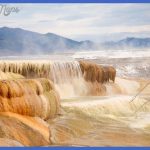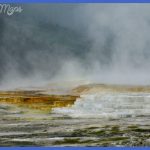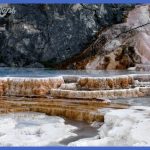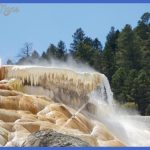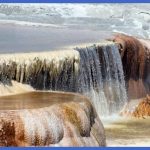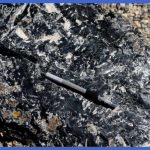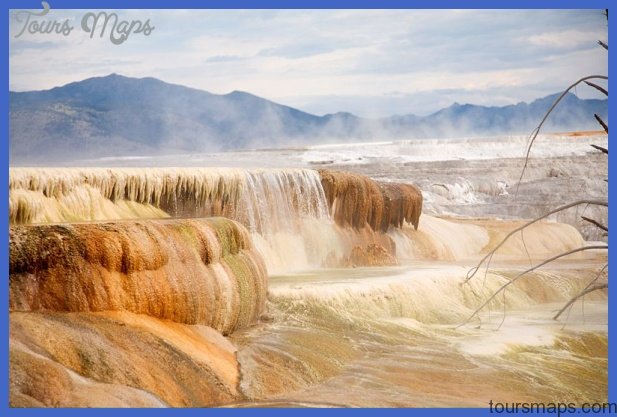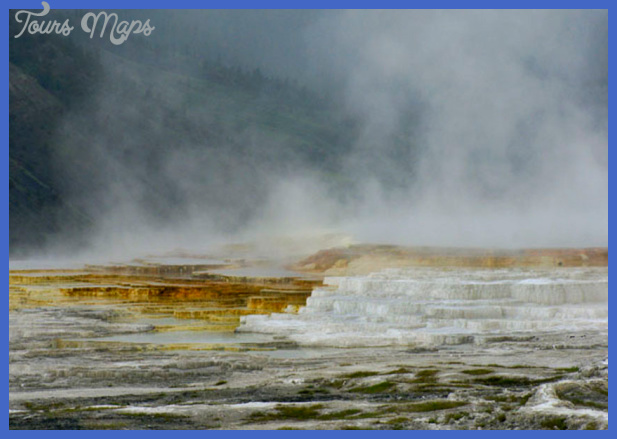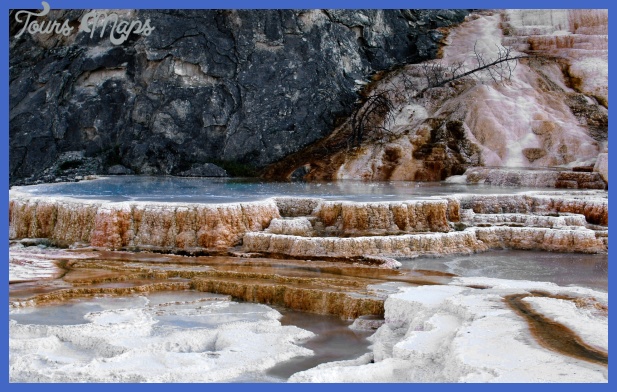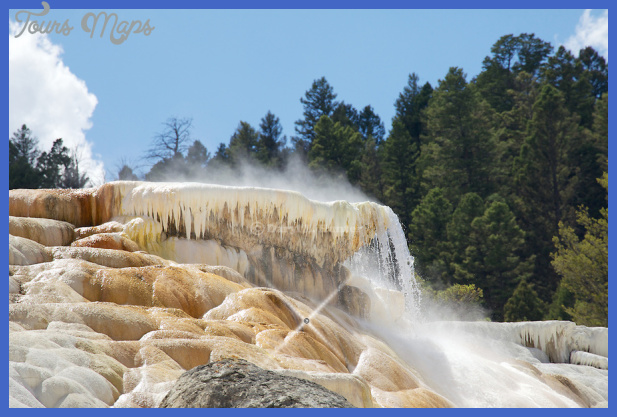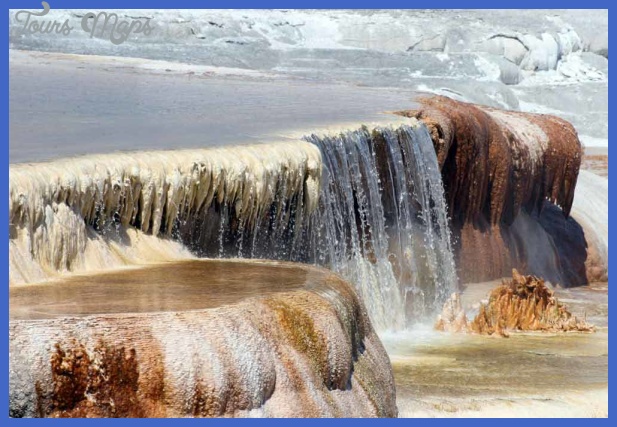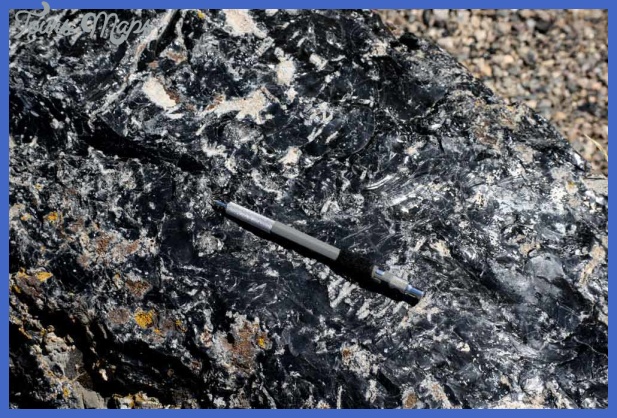Why are Firehole Lake and some of the nearby springs black? There are large amounts of manganese oxide being deposited, more than anywhere else in the park. In fact, George Henderson, tour guide in the 1880s and ’90s, liked to call this part of the Firehole River valley Ebony Basin. Around Firehole Lake, the mineral travertine, which is calcium carbonate in the form deposited by hot springs, is deposited along with geyserite (silicon dioxide). This is unusual, because in all but four of the park’s thermal areas, the geysers and hot springs deposit only geyserite. At Mammoth Hot Springs, the terraces are made entirely of travertine. The only other easily accessible area where both minerals are deposited is the Terrace Spring area near Madison Junction. Look for the egg-like travertine formations that exist in both Black Warrior and Firehole lakes. The first feature you encounter on the walkway is Excelsior Geyser.
The tremendous crater and prodigious overflow give you some idea what a stupendous geyser this must have been when active. The crater (sometimes called The Caldron in the park’s early days) measures over 250 by 300 feet (75 by 90 m). The constant steaming overflow has been measured at about 4000 gallons (15,000 L) per minute. For comparison, Old Faithful Geyser takes nearly two months to throw out as much water as Excelsior’s crater discharges in one day. The mustard yellow, orange, and brown runoff over the side of Excelsior’s crater into the Firehole is a perennial favorite of photographers. Early visitors called this geyser Hell’s Half Acre. Park Superintendent Norris applied that name to the whole geyser basin in 1881, changing the geyser’s name to Excelsior, meaning ever higher in Latin. When Excelsior erupted, enormous volumes of rock were thrown everywhere, and after an eruption, the Firehole River would have three times its normal volume. But these 300-foot (90 m) eruptions themselves may have destroyed the geyser.
Whatever the reason, there’s been only rare, minor activity during the last century. Notice the layers and layers of laminated sinter on the crater’s walls. Nearby Grand Prismatic Spring may have been overflowing and depositing sinter downslope for many centuries before Excelsior blew out its crater. If you’re walking beside the crater on a cool day, engulfed in steam next to the walls’ great drop-off, you may have a feeling of being at the edge of the earth. No photograph can capture that sensation. Ifyou take the boardwalk to the right when it forks, you’ll first encounter Turquoise Pool, which greatly resembles the semiprecious stone. The color is caused by light reflecting from minute particles suspended in its water. Grand Prismatic Spring drains into Turquoise, and Excelsior may have an underground connection with it as well. Sometimes the water drains nearly out of sight, but it slowly returns in subsequent months. Next along the path is Opal Pool, which got its name from the opalescence both of its water and its surrounding sinter. Opal is actually a geyser with rare but sometimes high eruptions. Opal’s water may disappear entirely or it may rise and fall with a period of about 2 hours. Midway Geyser Basin’s stellar attraction is Grand Prismatic Spring [GEO.22] . The largest hot spring in the park, it measures about 250 by 350 feet (75 by 100 m). Prismatic means brilliantly colored.
The central water in the spring is a brilliant blue, with blue-green near the edges. Radiating out from this are rays of yellow, orange, and brown the runoff channels. Since early days, visitors have remarked about the beautiful reflection of the pool’s colors in the steam. It’s dicult to get a good photo of a spring as huge as Grand Prismatic. Some of the best are taken from the air, but if you are determined to reach a good viewpoint, there’s a choice of two hills you might climb. East of the main road there’s Midway Bluff, and to the southwest of Grand Prismatic is a burned-over hill skirted by the Fairy Falls Trail (described at mile 11.3/5.7). What Makes the Colors? Wandering through Yellowstone’s thermal areas, you’ll see an amazing range of colors. The centers of the hot springs may be deep blue or blue-green or palest turquoise blue. The edges of the pools and their runoff channels will range from yellow through orange and red to brown, with light and dark greens here and there. What causes these different colors? Let’s start with the blue of the water. Sunlight penetrating the pool is scattered by the minute particles and molecules in the water. However, blue light is scattered more eciently than red or yellow, so the light coming toward you appears blue.
This same phenomenon occurs in the atmosphere to give us blue skies. Thus, in all but very shallow hot springs, we see blue centers. If there are some yellow or orange microorganisms growing on the sides of the pool (as at Emerald Pool in Black Sand Basin, for example), the water will appear blue-green or green, since yellow and blue make green. Scientists have found many different tiny living organisms in the hot springs, all generally called thermophilic microorganisms, meaning that they reproduce and prosper in hot places. Different species of bacteria, algae, and archaea thrive at different temperatures and at different degrees of acidity or alkalinity. Hyperthermophiles, that is, organisms that thrive in environments above 176°F (80°C), are found in the hottest water, while algae grow best where the runoffwater has cooled to about 113° or 122°F (45-50°C). Their various colors are due to pigments such as the yellow-green of chlorophyll in those organisms that use light as their source of energy, that is, the photosynthetic ones. The bright green Cyanidiales order of alga living in a prominent runoff channel in Porcelain Basin at Norris is an example.
Carotenoid pigments may contribute red, orange, or yellow. Another common pigment is melanin, which contributes a dark maroon or brown color to a relatively low-temperature alga (at about 95°F or 35°C) called Zygogonium. Non-photosynthetic bacteria live in the hottest water, while algae and photosynthetic bacteria occupy the cooler water farther from the hot spring source. Archaea use iron and precipitate it out. There are so many different families and genera of these tiny beings that scientists have only begun to find them and study their characteristics. As you travel in Yellowstone, you may notice colors around the hot springs other than the ones mentioned here. Not all the colors are organic; some are due to minerals. For example, iron-containing minerals are responsible for various shades of yellow and red around the acidic springs of Norris Geyser Basin. The pinks that stain some geyser cones are due to manganese-containing minerals. A great deal of manganese oxide in water will turn it black. Compounds of sulfur, arsenic, and mercury create some of the reds and yellows.
Black Water and Travertine Yellowstone Photo Gallery
Maybe You Like Them Too
- The Best Cities To Visit in The World
- World’s 10 Best Places To Visit
- Coolest Countries in the World to Visit
- Travel to Santorini, Greece
- Map of Barbados – Holiday in Barbados

